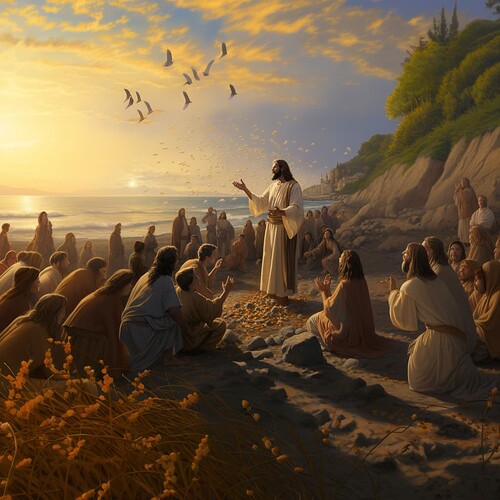 Introduction
Introduction
On January 11th, our journey through the Bible takes us to Matthew 13, a chapter rich with parables told by Jesus. Here, He reveals mysteries about the Kingdom of Heaven using simple yet profound stories, inviting us to understand and reflect on deeper spiritual truths.
 The Parable of the Sower
The Parable of the Sower
This chapter begins with the Parable of the Sower, illustrating different responses to the Word of God. It’s a powerful metaphor for how people receive and act on spiritual teachings.
Key Verse: “Listen then to what the parable of the sower means.” — Matthew 13:18
 The Parables of the Weeds, Mustard Seed, and Yeast
The Parables of the Weeds, Mustard Seed, and Yeast
Following the Sower, Jesus explains the parables of the Weeds, the Mustard Seed, and the Yeast. Each story offers unique insights into the nature and growth of God’s Kingdom, from its humble beginnings to its encompassing influence.
Key Verse: “The kingdom of heaven is like a mustard seed, which a man took and planted in his field.” — Matthew 13:31
 The Parables of the Hidden Treasure and the Pearl
The Parables of the Hidden Treasure and the Pearl
These parables highlight the incomparable value of the Kingdom of Heaven. They teach us about the joy and commitment involved in pursuing spiritual wealth over worldly riches.
Key Verse: “Again, the kingdom of heaven is like a merchant looking for fine pearls.” — Matthew 13:45
 The Parable of the Net
The Parable of the Net
Concluding with the Parable of the Net, Jesus illustrates the final judgment, where the righteous are separated from the wicked, emphasizing the importance of living a life aligned with God’s will.
Key Verse: “This is how it will be at the end of the age. The angels will come and separate the wicked from the righteous.” — Matthew 13:49
 Key Themes and Reflections:
Key Themes and Reflections:
Receptivity to God’s Word: The Parable of the Sower challenges us to examine how we receive and nurture the Word of God in our lives.
Growth and Influence of God’s Kingdom: The subsequent parables illustrate the dynamic and transformative nature of God’s Kingdom, growing from small beginnings to great influence.
Value and Commitment: The parables of the Hidden Treasure and the Pearl invite us to consider what we value most and our commitment to pursuing spiritual riches.
Final Judgment and Accountability: The Parable of the Net reminds us of the inevitability of judgment and the importance of righteous living.
 Today’s Application:
Today’s Application:
Reflect on your own receptivity to God’s Word. Contemplate the growth of your faith and how it influences others. Consider what you value most and how you demonstrate your commitment to God’s Kingdom. Ponder the implications of the final judgment in your daily choices and actions.
 Hidden Gem:
Hidden Gem:
Did you know? Parables were a common teaching method in ancient times, allowing complex concepts to be conveyed in relatable and memorable ways.
 Reflective Q&A:
Reflective Q&A:
![]() Understanding the Kingdom through Parables: How do these parables deepen your understanding of the Kingdom of Heaven?
Understanding the Kingdom through Parables: How do these parables deepen your understanding of the Kingdom of Heaven?
A: These parables use everyday scenarios to reveal profound truths about the Kingdom of Heaven, making its mysteries more accessible and relatable. They encourage us to think deeply about the nature of faith, growth, value, and judgment in the spiritual realm.
![]() Applying Parables to Modern Life: How can we apply the lessons of these parables in our contemporary context?
Applying Parables to Modern Life: How can we apply the lessons of these parables in our contemporary context?
A: We can apply these parables by evaluating how we respond to God’s Word, nurturing our spiritual growth, prioritizing our pursuit of the Kingdom, and living in a way that reflects readiness for the final judgment.
 Join the Discussion:
Join the Discussion:
How have these parables from Matthew 13 impacted your spiritual perspective? Share your insights and reflections in the comments below!
#Parables #KingdomOfHeaven #SpiritualGrowth #BibleStudy #Matthew13
![]() See You Tomorrow in Matthew: Continue your enriching journey with us as we explore more teachings and parables of Jesus, deepening our understanding of His message.
See You Tomorrow in Matthew: Continue your enriching journey with us as we explore more teachings and parables of Jesus, deepening our understanding of His message.
 Join the forum!
Join the forum!
Enhance your spiritual journey in our AIgniteScripture Community. Connect with others who are exploring their faith:
Free Members: Join lively discussions, access a range of biblical resources, and grow in your faith journey. Sign up here: 🌟 How to Join Page - Membership Options
Supporters Membership ($20/month or $200/year): Gain deeper insights with exclusive newsletters, special forum access, and more. Contribute to our community through your engagement and insights. Become a Supporter: 🌟 How to Join Page - Membership Options
![]() Stay Connected with our AIgniteScripture Newsletter: Follow our daily readings and insights, and be part of our journey through the Bible enhanced by AI perspectives. Subscribe now: https://newsletter.aignitescripture.com/
Stay Connected with our AIgniteScripture Newsletter: Follow our daily readings and insights, and be part of our journey through the Bible enhanced by AI perspectives. Subscribe now: https://newsletter.aignitescripture.com/
